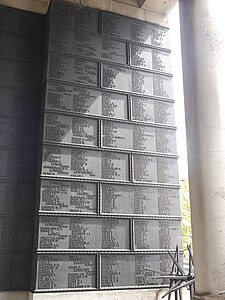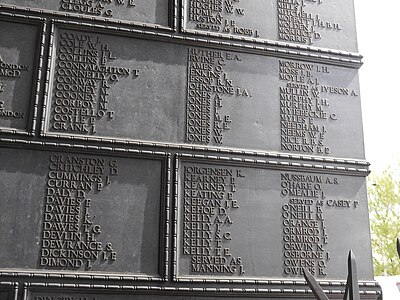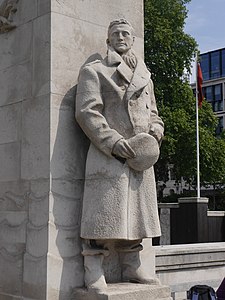Tower Hill Memorial
| Tower Hill Memorial | |
|---|---|
| Commonwealth War Graves Commission | |
| For men and women of the Merchant Navy and fishing fleets who died in both World Wars and who have no known grave | |
| Unveiled | 12 December 1928 5 November 1955 |
| Location | 51°30′35″N 0°04′40″W / 51.5097°N 0.0777°W |
| Designed by | Sir Edwin Lutyens Sir Edward Maufe |
| Commemorated | 36,087 |
First World War TO THE GLORY OF GOD AND TO THE HONOUR OF TWELVE THOUSAND OF THE MERCHANT NAVY AND FISHING FLEETS WHO HAVE NO GRAVE BUT THE SEA Second World War THE TWENTY FOUR THOUSAND OF THE MERCHANT NAVY AND FISHING FLEETS WHOSE NAMES ARE HONOURED ON THE WALLS OF THIS GARDEN GAVE THEIR LIVES FOR THEIR COUNTRY AND HAVE NO GRAVE BUT THE SEA | |
| Statistics source: Cemetery details. Commonwealth War Graves Commission. | |
Listed Building – Grade I | |
| Official name | The Mercantile Marine First World War Memorial |
| Designated | 27 September 1973 |
| Reference no. | 1260087 |
Listed Building – Grade II* | |
| Official name | Merchant Seamen's Memorial |
| Designated | 15 April 1998 |
| Reference no. | 1031597 |
The Tower Hill Memorial is a pair of
The first memorial was commissioned in light of the heavy losses sustained by
Merchant shipping losses in the Second World War were significantly higher than in the first (4,786 ships, 32,000 lives) and the IWGC commissioned a second memorial on the same site, intended to complement the first. Maufe designed a sunken garden, accessed by steps behind the original memorial, the walls of which were again clad with bronze panels with the names of the missing. At regular intervals between the panels are relief sculptures (by
The memorials to the world wars are both listed buildings—the Mercantile Marine Memorial is grade I and part of a national collection of Lutyens' war memorials, and Maufe's Merchant Seamen's Memorial is listed at grade II*. The Falklands War memorial is not listed.
First World War memorial
Background

In the aftermath of the
The IWGC and its founder,
History

The IWGC sought advice on the form of the memorial from the seafarers' unions, who consistently requested a memorial in the form of a home for aged seamen or similar, but the commission was set against functional memorials in the belief that they became associated more with their function than with commemoration. It rejected the request, overruling its own advisory committee in doing so, on the grounds that its charter did not allow it to fund the ongoing costs of an institution. It insisted that merchant seamen would be commemorated on a monument.[7]
The commission first intended to site the memorial at Temple Steps, on the bank of the
Lutyens described the RFAC's opinion as "bosh", and suggested to Ware that they should continue regardless and force a confrontation. Ware was more diplomatic, and the IWGC chose a new site in Trinity Square Gardens on Tower Hill, still west of Tower Bridge but further from the river.[1][9][10][11] This site was considered appropriate because it was within sight of the Thames, albeit not on the riverbank, and the area already had maritime connections, including the headquarters of the Port of London Authority at 10 Trinity Square, Trinity House, and the church of All Hallows-by-the-Tower (itself home to many nautically themed memorials).[1][12] Philip Longworth, in a history of the IWGC, remarked that the location meant the commission's only memorial in London "would never be seen by most Londoners, still less find a place in the national consciousness as did Lutyens' stark monument on Whitehall". (The Cenotaph was not commissioned by the IWGC.)[13]
| Mercantile Marine Memorial Act 1927 | |
|---|---|
| Act of Parliament | |
 17 & 18 Geo. 5. c.xxvi | |
| Dates | |
| Royal assent | 29 June 1927 |
| Text of statute as originally enacted | |
Trinity Square Gardens was
Design


The main structure is in
The memorial's main dedication is in bronze letters to the front (south) of the attic: TO THE GLORY OF GOD AND TO THE HONOUR OF TWELVE THOUSAND OF THE MERCHANT NAVY AND FISHING FLEETS WHO HAVE NO GRAVE BUT THE SEA; above it are the dates of the First World War (1914–1918), which are also carved into the stone on north side. To either side are decorative bronze wreaths. On the inside, the floor is in black and white stone in a chequerboard pattern. On the north side, bronze spikes occupy the otherwise-open bays.[1][20][21]
The largest single loss of life commemorated on the memorial is from the sinking of the RMS Lusitania on 7 May 1915. Of the 1,200 dead, more than 350 British crew members are commemorated on the Mercantile Marine memorial.[22] In total, the First World War memorial records the names of some 12,000 casualties.[1]
In his biography of Lutyens, Michael Barker described the design as "dignified classicism";[23] another Lutyens biographer, Christopher Hussey, described it as a "classical shrine".[24] Tim Skelton, author of Lutyens and the Great War, notes the similarity of the colonnade to the shelter buildings in Lutyens' cemeteries in France and Belgium and suggests that the memorial would be "equally well at home on the Western Front as in the heart of London".[25] The resemblance to the cemetery buildings is also noted by the Dutch architect Jeroen Geurst, who compares it in particular to those at Hooge Crater in Belgium and Serre Road in France.[26] In the opinion of the historian David Crane, the memorial never recovered from its "miserable start" and is consequently the least well-known of the IWGC's major works following the First World War.[6]
- Plaques bearing the names of the dead from the RMS Lusitania, the largest single loss of life to be commemorated on the Mercantile Marine Memorial
Second World War memorial


Background
From the outbreak of the
The architect was Edward Maufe, who began his career designing churches and by the 1950s was the IWGC's principal architect for the United Kingdom for the Second World War commemorations. Maufe was also responsible for the Air Forces Memorial in Surrey and extensions to the Plymouth, Portsmouth, and Chatham naval memorials.[17][28][29][30]
History
| Merchant Navy Memorial Act 1952 | |
|---|---|
| Act of Parliament | |
 15 & 16 Geo. 6 & 1 Eliz. 2. c. xv | |
| Dates | |
| Royal assent | 9 July 1952 |
| Text of statute as originally enacted | |
Following the Second World War, the IWGC considered various sites for a memorial to the new casualties but, after consultation with the relevant public bodies, decided Tower Hill was the most appropriate location. The commission briefed Maufe that the new memorial should complement Lutyens' design and fit in with the existing architecture in the area, including the Port of London Authority building. Maufe first proposed extending Lutyens' structure with a further colonnade, but this was rejected. His next design, for a sunken garden, was accepted. Another Act of Parliament was required, which was passed in July 1952 as the Merchant Navy Memorial Act. Work began later in 1952 and was completed in 1955. Some modifications to Maufe's design were necessary. Maufe initially planned a larger grassy area between Lutyens' colonnade and the sunken garden with a Stone of Remembrance at the centre. The stone was eliminated and the grass scaled back to reduce the overall size of the memorial and assuage the concerns of local people. The depth of the garden had to be reduced at the south end because of a London Underground tunnel.[31][32]
The memorial commemorates merchant seamen from ships registered in Britain or its Empire or on loan to the governments of those countries, and who were lost at sea as a result of enemy action in the Second World War; it lists 23,765 men, of whom 832 were fishermen and 80 maritime pilots and lighthousemen. The much larger casualty figures and corresponding scale of the memorial reflect the vital contribution of the
Design
The Second World War memorial takes the form of a semi-circular sunken garden located behind the First World War Memorial, to its north in Trinity Square Gardens. The idea of a sunken garden appears to have originated from discussions immediately following the end of the war. There was a feeling among the new generation of artists and architects that the elaborate and artistic memorials to the First World War did not capture the national mood of mourning for the new wave of casualties and that spaces such as gardens, which provided a location for individual mourning and reflection, were more suitable. According to the architectural historian Philip Ward-Jackson, Maufe's memorial gives the impression of being a wing of an imaginary ruined church, complete with provided seats—an image which would have had "powerful resonance in the bombed City" (much of the surrounding area, including the Port of London Authority building, was severely damaged by German bombing).[35][36] The architectural historian Nikolaus Pevsner described Maufe's extension as "less assertive" than the original memorial; he praised the idea of a memorial to the missing in the form of a void (the sunken garden), but felt it was let down by Wheeler's "strangely jaunty" reliefs between the lists of names.[37]
- Sculptures at the entrance to the sunken garden
-
The eastern sentry, a Merchant Navy seaman
-
The two sentries flanking the stone bearing the main dedication
-
The western sentry, a Merchant Navy officer
The ground-level entrance area to the Second World War memorial is on the southern side of the sunken garden and consists of two
- Wheeler's allegorical sculptures representing the Seven Seas
Later history

The Tower Hill memorial commemorates 36,087 seafarers from both world wars.
Since 2000, 3 September has been celebrated annually as Merchant Navy Day; a memorial service is held close to that date at the Tower Hill Memorial.
Liverpool marked the 70th anniversary of the Battle of the Atlantic, the longest continuous military campaign in World War II, by having twenty-five warships sail through the port to mark the milestone. [49] Ceremonies were also held at the Tower Hill Memorial on 11 May 2013, along with other events elsewhere in London and Britain.[50][a]
Lutyens' First World War Memorial became a grade II* listed building in 1973. Listed status offers legal protection from demolition or modification; grade II* is reserved for "particularly important buildings of more than special interest" and is applied to about 5.5% of listings. It was upgraded to grade I status (which is applied to around 2.5% of listed buildings, those of "the greatest historic interest") in November 2015 when Lutyens' war memorials were declared a national collection.[1][52][53] Maufe's Merchant Seamen's Memorial has separately been a grade II* listed building since 1998.[31] The CWGC began a major restoration project of the colonnade in 2019.[54]
See also
- List of ships named on the Tower Hill Memorial
- Grade I listed war memorials in England
- Grade II* listed war memorials in England
- Grade I and II* listed buildings in the London Borough of Tower Hamlets
- List of Commonwealth War Graves Commission World War I memorials to the missing
- List of Commonwealth War Graves Commission World War II memorials to the missing
Footnotes
- ^ According to The Times, a further service was planned for 17 October 2017, organised by several maritime organisations and due to be attended by 400 people, including foreign diplomats and Anne, Princess Royal, to mark 100 years since the introduction of the convoy system. The service was cancelled at short notice as the organisers were unable to obtain permission for a road closure which was required for the event.[51]
References
Bibliography
- Amery, Colin; et al. (1981). Lutyens: The Work of the English Architect Sir Edwin Lutyens. London: ISBN 9780728703032.
- Barker, Michael (2005). Sir Edwin Lutyens. Oxford: ISBN 9780747805823.
- Boorman, Derek (1995). For Your Tomorrow: British Second World War Memorials. ISBN 9780951365410.
- Boorman, Derek (2005). A Century of Remembrance: One Hundred Outstanding British War Memorials. ISBN 9781844153169.
- ISBN 9780850523638.
- Corke, Jim (2005). War Memorials in Britain. Oxford: ISBN 9780747806264.
- ISBN 9780007456659.
- Geurst, Jeroen (2010). Cemeteries of the Great War by Sir Edwin Lutyens. Rotterdam: 010 Publishers. ISBN 9789064507151.
- ISBN 9780907462590.
- Longworth, Philip (2010). The Unending Vigil: The History of the Commonwealth War Graves Commission. ISBN 9781848844230.
- ISBN 9780719537776.
- Matthews, Peter (2012). London's Statues and Monuments. Oxford: ISBN 9780747807988.
- ISBN 9780300096248.
- Quinlan, Mark (2005). British War Memorials. Hereford: Authors Online. ISBN 9780755201860.
- ISBN 9780712668224.
- Saunders, David (1996). Britain's Maritime Memorials and Mementoes. ISBN 9781852604660.
- Skelton, Tim; Gliddon, Gerald (2008). Lutyens and the Great War. London: ISBN 9780711228788.
- ISBN 9781858943749.
- Summers, Julie (2010). British and Commonwealth War Cemeteries. Oxford: ISBN 9780747807896.
- Ward, G. Kingsley; Gibson, Edwin (1989). Courage Remembered. Toronto: ISBN 9780771087868.
- Ward-Jackson, Philip (2003). Public Sculpture of the City of London. Public Sculpture of Britain. Liverpool: ISBN 9780853239772.
Citations
- ^ a b c d e f g h i j Historic England. "The Mercantile Marine First World War Memorial (1260087)". National Heritage List for England. Retrieved 6 January 2018.
- ^ a b c "Tower Hill Memorial: History". Commonwealth War Graves Commission. Retrieved 2 May 2018.
- doi:10.1093/ref:odnb/34638. (Subscription or UK public library membershiprequired.)
- ^ Lutyens, p. 153.
- ^ Summers (2010), p. 39, 45.
- ^ a b c d Crane, p. 198.
- ^ a b Longworth, p. 97.
- ^ Ridley, pp. 348–349.
- ^ a b Ward-Jackson, p. 410.
- ^ a b Skelton, p. 94.
- ^ Amery, p. 154.
- ^ Pevsner, p. 610.
- ^ Longworth, pp. 98–99.
- ^ Ward-Jackson, p. 411.
- ^ Skelton, p. 95.
- ^ Ward, p. 167
- ^ a b "Tower Hill Memorial: Design". Commonwealth War Graves Commission. Retrieved 1 May 2018.
- ^ Saunders, p. 78.
- doi:10.1093/ref:odnb/32813. (Subscription or UK public library membershiprequired.)
- ^ a b Boorman (2005), p. 182
- ^ Imperial War Museums. Retrieved 5 May 2018.
- ^ "The Tower Hill Memorial". Commonwealth War Graves Commission. 25 October 2017. Retrieved 24 February 2018.
- ^ Barker, p. 41.
- ^ Hussey, p. 474.
- ^ Skelton, p. 172.
- ^ Geurst, pp. 56, 92.
- ^ Longworth, pp. 194–195.
- ^ Corke, pp. 45–46.
- doi:10.1093/ref:odnb/31429. (Subscription or UK public library membershiprequired.)
- ^ Borg, pp. 82–83.
- ^ a b c d Historic England. "Merchant Seamen's Memorial (1031597)". National Heritage List for England. Retrieved 30 April 2018.
- ^ a b Ward-Jackson, p. 412.
- ^ Summers (2010), p. 45.
- ^ a b Quinlan, p. 219.
- ^ Ward-Jackson, p. 414.
- ^ Boorman (1995), p. 72.
- ^ Pevsner, p. 611.
- ^ Matthews, p. 92.
- doi:10.1093/ref:odnb/31824. (Subscription or UK public library membershiprequired.)
- ^ "Tower Hill Memorial". Commonwealth War Graves Commission. Retrieved 2 May 2018.
- ^ Summers (2007), p. 24.
- ^ Longworth, p. 195
- ^ Register of the Mercantile Marine memorial, Tower Hill, London, compiled ... by order of the Imperial War Graves Commission. Imperial War Graves Commission. 1928. Retrieved 26 May 2018 – via National Library of Australia.
- ^ "M.N. Roll of Honour". The Nautical Magazine. 179: 235. 1958.
- ^ "One Hundred and First Annual Report". Annual Report of the Mercantile Marine Service Association. 101: 2. 1958.
- ^ "Tower Hill Memorial: Visit". Commonwealth War Graves Commission. Retrieved 27 May 2018.
- ^ Quinlan, p. 218.
- Imperial War Museums. Retrieved 5 May 2018.
- ^ "Battle of the Atlantic: Liverpool marks 70th anniversary". BBC News. 25 May 2013. Retrieved 25 September 2020.
- ^ "UK remembers Battle of the Atlantic 70 years on". BBC News. 8 May 2013. Retrieved 20 May 2018.
- ^ Brown, David (6 October 2017). "Merchant navy service is sunk by London council's refusal to waive red tape". The Times. Retrieved 19 July 2018.(subscription required)
- ^ "The Listing and Grading of War Memorials". Historic England. July 2015. p. 2. Archived from the original on 21 October 2016. Retrieved 10 February 2017.
- ^ "National Collection of Lutyens' War Memorials Listed". Historic England. 7 November 2015. Retrieved 20 May 2018.
- ^ "London's Hidden Gem War Memorial to be Restored". Commonwealth War Graves Commission. Retrieved 27 March 2022.
External links
- Tower Hill: 'Lest we forget' (includes an index of all the ships named on the memorial)
- Queen Mary unveils Mercantile Marine Memorial [12 December 1928] (British Pathé news reel)
- Queen Elizabeth II unveils Merchant Navy Memorial: clip 1 clip 2 [5 November 1955] (British Pathé news reels)















